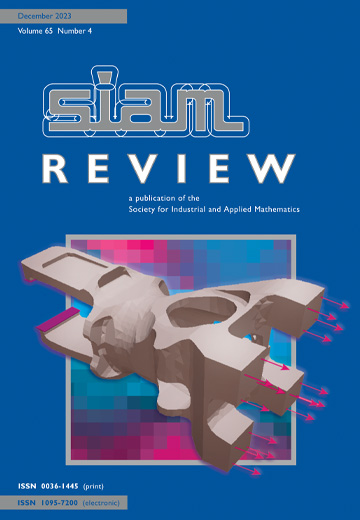调查和审查
IF 6.1
1区 数学
Q1 MATHEMATICS, APPLIED
引用次数: 0
摘要
SIAM评论,第65卷第4期,第917-917页,2023年11月。图$G=(V,E)$的度量维数$\beta(G)$是顶点子集$S$的最小基数,使得所有其他顶点都由它们到解析集$S$中顶点的距离唯一确定。求图的度量维数是一个NP难题。确定度量维度是否小于给定值是NP完全的。Richard C.Tillquist、Rafael M.Frongillo和Manuel E.Lladser在本期调查与评论部分的第一篇文章《获得离散空间中的土地布局:度量维度及其应用调查》中对度量维度进行了详尽的介绍。其重要结果概述包括博弈论中的应用、传输过程中的源定位以及生物序列数据计算分析中的预处理。这篇论文值得广大读者阅读。Ludovic Chamoin和Frédéric Legoll的第二篇综述文章是“有限元计算中的后验误差估计的介绍性综述”。它致力于提供可计算和数学验证误差边界的验证方法的基本概念和工具,并解决了空间域中误差定位的问题。这篇综述的重点是一个特殊的方法和问题,即线性椭圆扩散问题的协调有限元方法。对偶分析工具和平衡概念使人们能够统一看待不同的后验误差估计方法,例如通量恢复方法、残差方法和基于对偶的本构关系误差方法。考虑的其他主题是面向目标的误差估计、计算成本以及对其他有限元方案和其他数学问题的扩展。虽然演示是自包含的,但假设读者熟悉有限元方法。本文采用跨学科的写作风格,旨在对应用数学家和工程师有用。本文章由计算机程序翻译,如有差异,请以英文原文为准。
Survey and Review
SIAM Review, Volume 65, Issue 4, Page 917-917, November 2023.
The metric dimension $\beta(G)$ of a graph $G = (V,E)$ is the smallest cardinality of a subset $S$ of vertices such that all other vertices are uniquely determined by their distances to the vertices in the resolving set $S$. Finding the metric dimension of a graph is an NP-hard problem. Determining whether the metric dimension is less than a given value is NP-complete. In the first article in the Survey and Review section of this issue, “Getting the Lay of the Land in Discrete Space: A Survey of Metric Dimension and Its Applications,” Richard C. Tillquist, Rafael M. Frongillo, and Manuel E. Lladser provide an exhaustive introduction to metric dimension. The overview of its vital results includes applications in game theory, source localization in transmission processes, and preprocessing in the computational analysis of biological sequence data. The paper is worth reading for a broad audience. The second Survey and Review article, by Ludovic Chamoin and Frédéric Legoll, is “An Introductory Review on A Posteriori Error Estimation in Finite Element Computations.” It is devoted to basic concepts and tools for verification methods that provide computable and mathematically certified error bounds and also addresses the question on the localization of errors in the spatial domain. The focus of this review is on a particular method and problem, namely, a conforming finite element method for linear elliptic diffusion problems. The tools of dual analysis and the concept of equilibrium enable a unified perspective on different a posteriori error estimation methods, e.g., flux recovery methods, residual methods, and duality-based constitutive relation error methods. Other topics considered are goal-oriented error estimation, computational costs, and extensions to other finite element schemes and other mathematical problems. While the presentation is self-contained, it is assumed that the reader is familiar with finite element methods. The text is written in an interdisciplinary style and aims to be useful for applied mathematicians and engineers.
The metric dimension $\beta(G)$ of a graph $G = (V,E)$ is the smallest cardinality of a subset $S$ of vertices such that all other vertices are uniquely determined by their distances to the vertices in the resolving set $S$. Finding the metric dimension of a graph is an NP-hard problem. Determining whether the metric dimension is less than a given value is NP-complete. In the first article in the Survey and Review section of this issue, “Getting the Lay of the Land in Discrete Space: A Survey of Metric Dimension and Its Applications,” Richard C. Tillquist, Rafael M. Frongillo, and Manuel E. Lladser provide an exhaustive introduction to metric dimension. The overview of its vital results includes applications in game theory, source localization in transmission processes, and preprocessing in the computational analysis of biological sequence data. The paper is worth reading for a broad audience. The second Survey and Review article, by Ludovic Chamoin and Frédéric Legoll, is “An Introductory Review on A Posteriori Error Estimation in Finite Element Computations.” It is devoted to basic concepts and tools for verification methods that provide computable and mathematically certified error bounds and also addresses the question on the localization of errors in the spatial domain. The focus of this review is on a particular method and problem, namely, a conforming finite element method for linear elliptic diffusion problems. The tools of dual analysis and the concept of equilibrium enable a unified perspective on different a posteriori error estimation methods, e.g., flux recovery methods, residual methods, and duality-based constitutive relation error methods. Other topics considered are goal-oriented error estimation, computational costs, and extensions to other finite element schemes and other mathematical problems. While the presentation is self-contained, it is assumed that the reader is familiar with finite element methods. The text is written in an interdisciplinary style and aims to be useful for applied mathematicians and engineers.
求助全文
通过发布文献求助,成功后即可免费获取论文全文。
去求助
来源期刊

SIAM Review
数学-应用数学
CiteScore
16.90
自引率
0.00%
发文量
50
期刊介绍:
Survey and Review feature papers that provide an integrative and current viewpoint on important topics in applied or computational mathematics and scientific computing. These papers aim to offer a comprehensive perspective on the subject matter.
Research Spotlights publish concise research papers in applied and computational mathematics that are of interest to a wide range of readers in SIAM Review. The papers in this section present innovative ideas that are clearly explained and motivated. They stand out from regular publications in specific SIAM journals due to their accessibility and potential for widespread and long-lasting influence.
 求助内容:
求助内容: 应助结果提醒方式:
应助结果提醒方式:


